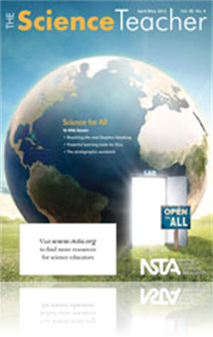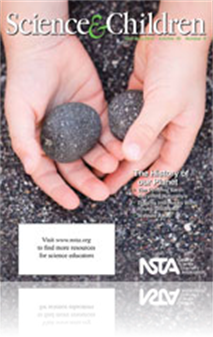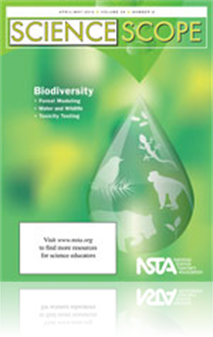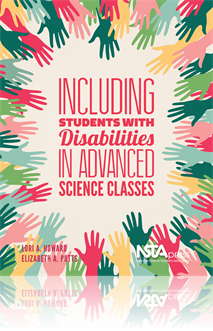All Resources
Journal Article
Laboratory experiences, and not just textbooks, are the best way to provide equal learning opportunities for all....
Journal Article
Science 101: How Do We Figure Out What Happened to the Earth in the Past?
This column provides background science information for elementary teachers. This month’s issue discusses the layers of the Earth....
Journal Article
Safer Science: SDS: Step One to Safety
This column provides best safety practices for the science classroom and laboratory. This month’s issue discusses the new system of classification and labeling of chemicals....
Journal Article
Exploring Biodiversity's Big Ideas in Your School Yard
Exploring biodiversity in your school yard is an excellent way to engage students in learning about the natural world and provides them with skills and knowledge that will support students to successfully understand ecosystems....
Journal Article
Methods and Strategies: Poor, Poor Pluto
This column provides ideas and techniques to enhance your science teaching. In this month’s issue teachers develop a research project surrounding Pluto's lost planetary status....
Journal Article
Powerful Learning Tools for ELLs
Using native language, familiar examples, and concept mapping to teach English language learners....
Journal Article
Editor's Note: The History of Our Planet
Science and Children’s editor shares thoughts regarding the current issue....
Journal Article
The Early Years: Water Leaves "Footprints"
This column discusses resources and science topics related to students in grades preK to 2. This month’s issue discusses an activity to help students learn how water shapes the Earth's surface....
Journal Article
The Human Impact on Biodiversity: A Case Study With Corn
Explore how agricultural practices affect biodiversity....
Journal Article
Science 2.0: Paper Slide Videos
This column shares web tools that support learning. This month’s issue explores making paper slide videos in which students collaborate to publish creative, low-tech video projects that demonstrate their understanding of science concepts....
Journal Article
Our Watery World: Teaching Middle School Students About Biodiversity
Explore local natural areas to reinforce the importance of water to life on Earth....
Journal Article
The New Teacher's Toolbox: Your First Conference
This column shares tips for teachers just beginning their career. This month’s issue offers strategies for a beneficial conference experience....
Journal Article
Digging Into Rocks With Young Children
An investigation uncovers student knowledge of rocks while laying a foundation for scientific understanding....
Journal Article
Blending Language Learning With Science
With purposeful planning, teachers can reach all students with the dual goals of language development and scientific inquiry....
Journal Article
Career of the Month: Astrophysicist
This column shares interviews with professionals using science in the workplace. This month’s issue describes an astrophysicist's schooling and job....
Journal Article
Testing for Toxins Using <i>Daphnia spp.</i> and Table Salt
Conduct a simple toxicity test with a familiar chemical. Students learn about key concepts in science, including measuring volume and mass, serial dilutions, and data collection and interpretation....
Journal Article
Editor's Roundtable: Respect the Web
Science Scope’s editor shares thoughts regarding the current issue....
Journal Article
A musical rap strengthens students' academic understanding of the circulatory system....
Journal Article
This article describes an approach in which students develop and apply definitions prior to their formal introduction to new vocabulary. The example given is an inquiry-based lesson on geologic principles. ...
Book Chapter
Classroom Considerations: Behavior
Behavior management is probably never an issue in your advanced-level science class, and you should not assume that it will be now that you have a student with a disability in your class. Remember that good preparation on your part will go a long way...
Book Chapter
Basic Special Education Terms and Laws
Science teachers are not responsible for knowing the intricacies of disabilities and disability laws, but the fact that students with disabilities will be in the classroom means that they need to have at least a working knowledge of disability termin...
Book Chapter
The science teacher is an important member of the IEP team—bringing unique knowledge and perspective—and communication with the rest of the team will lead to the best possible outcome for students with disabilities in advanced science classes. Th...
Book Chapter
Classroom Considerations: Instruction
This chapter focuses on the classroom. When students with disabilities are part of an advanced class, the content of the class will remain the same but the science teacher may need to make some slight adjustments to the instruction to ensure that all...
Book Chapter
Laboratory experiments are an essential component to the accelerated classroom and provide an interactive learning environment linking science concepts to “real world” observations. While the actual laboratory experiments or exercises will vary d...
Book Chapter
Assistive Technology and Your Classroom
Incorporation of technology into the advanced classroom has flourished as the national focus on success in STEM classes has accelerated. The assumption is that new technologies support student learning of scientific concepts and processes. Being rec...
Book Chapter
This chapter addresses requesting testing accommodations for students who need them from either the College Board or International Baccalaureate (IB). Planning is essential to success, so identifying which students will need to have testing accommod...
Book Chapter
One of the most important foundations for student success is the teacher. Particularly important is being open and willing to welcome students with disabilities into the classroom. The discussion in this chapter addresses concerns related to recruiti...
Journal Article
Science 101: What's Really Going on in Electric Circuits?
This column provides background science information for elementary teachers. In this month’s issue the author explores electric circuits....
Journal Article
Research and Teaching: Assessing the Effects of Prior Conceptions on Learning Gene Expression
Gene expression is a highly theoretical concept that requires advanced reasoning skills to comprehend. Often, students receive instruction but fail to replace prior conceptions and thus do not benefit. To investigate the reason for this failure, we u...
Journal Article
Learning the Ropes With Electricity
Students create a hands-on classroom model illustrating a closed circuit along with other activities that explore the flow of electricity through modeling....
Journal Article
Case Study: Applying Newton's Third Law of Motion in the Gravitron Ride
This column provides original articles on innovations in case study teaching, assessment of the method, as well as case studies with teaching notes. In this month’s issue students learn about centripetal and frictional forces through a case study i...
Journal Article
Supercharging Lessons With a Virtual Lab
A virtual lab supplements an exploration of simple circuits....
Journal Article
Formative Assessment Probes: When Equipment Gets in the Way
This column focuses on promoting learning through assessment. This month’s issue discusses how to elicit students' initial ideas about how to light a bulb with a battery and a wire....
Journal Article
The <i>Next Generation Science Standards</i>: A Focus on Physical Science
This article focuses on the NGSS disciplinary core ideas in physical science, the development of those ideas across time, the importance of blending core ideas with scientific and engineering practices to build understanding, and the development of p...
Journal Article
In Pursuit of Sustainable STEM Certification Programs
This article investigates the impact of a unique prescholarship internship available to freshman and sophomore science majors who are exploring the possibility of becoming secondary STEM teachers....
Journal Article
Safety First: Getting Wired on Safety
This column provides best safety practices for the science classroom. This month's issue discusses safety when doing electrical activities. ...
Journal Article
Methods and Strategies: Birds of a Feather . . .
This column provides ideas and techniques to enhance your science teaching. This month’s issue investigates birds....










